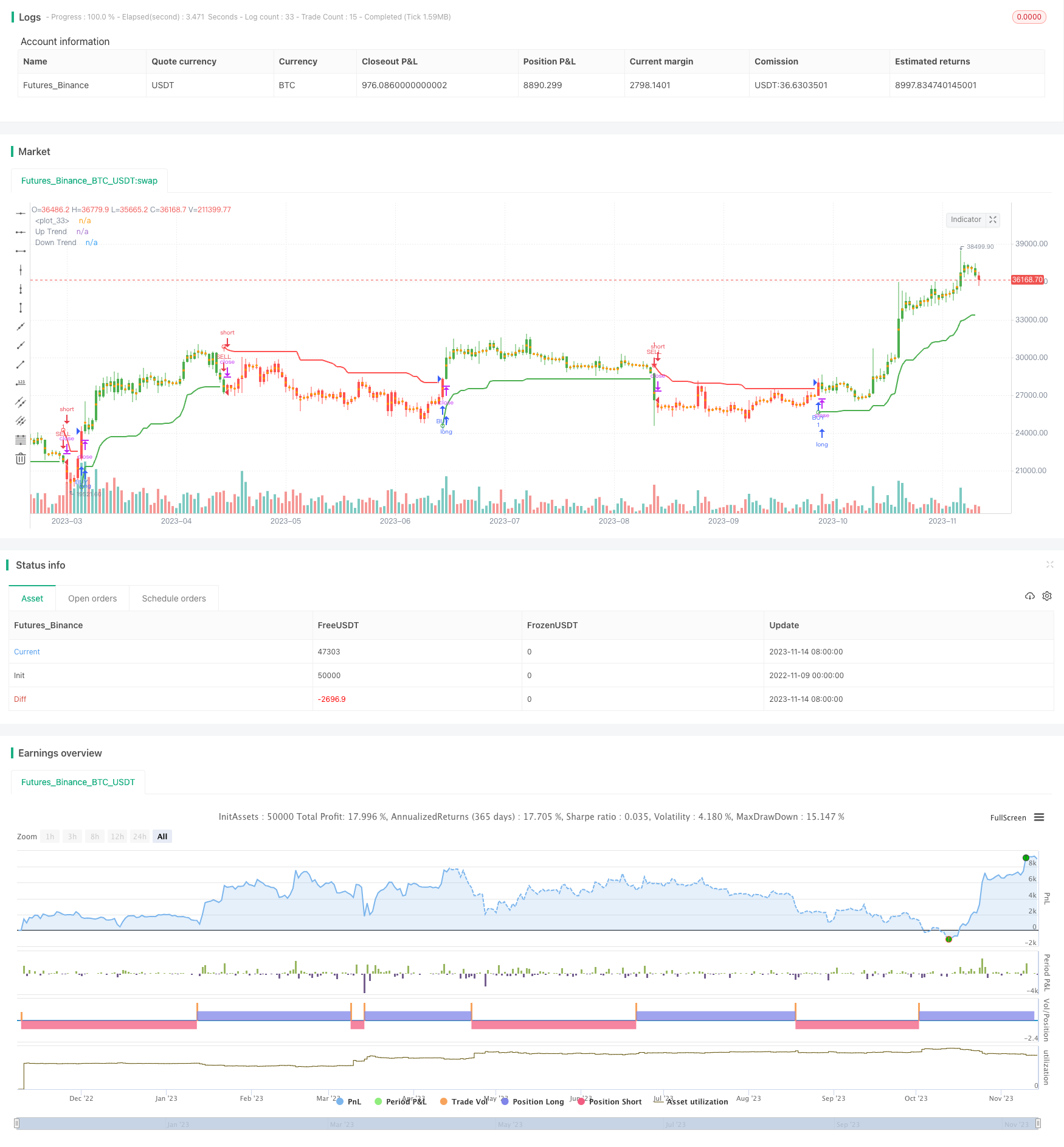
Overview
This strategy generates long and short signals through dual moving averages and implements tracking stop loss. The core idea is to determine the trend direction with moving averages, go long or short along the trend, and use ATR to calculate the stop loss for tracking stop loss.
Strategy Logic
This strategy uses hl2 as the source price and calculates ATR of a certain period as the stop loss range. The upper and lower bands are calculated based on ATR multiplied by a certain factor. When the price breaks above the upper band, a buy signal is generated to go long. When the price breaks below the lower band, a sell signal is generated to go short.
After opening positions, the stop loss is adjusted in real-time based on the changes in ATR to achieve tracking stop loss. Specifically, after going long, the lower band is raised progressively based on the latest low to track the stop loss. After going short, the upper band is lowered progressively based on the latest high to track the stop loss.
In this way, this strategy makes full use of moving averages’ capability of determining trend direction, and also incorporates the tracking stop loss mechanism based on ATR to ensure trading direction and risk control.
Advantages
The biggest advantage of this strategy lies in risk control. Traditional moving average strategies only consider directional judgments and can easily blow up accounts. By incorporating ATR for tracking stop loss, this strategy can dynamically adjust stop loss based on market volatility to effectively control trading risks.
In addition, this strategy combines dual-directional trading. Compared to single-direction strategies, it can promptly adjust position directions when trends reverse, avoiding being trapped in one direction and improving strategy profitability.
Risks
The main risks of this strategy come from the parameter settings of ATR period and multiplier. If ATR period is too short or multiplier too large, the stop loss range would be too small to effectively control risks. If ATR period is too long or multiplier too small, the stop loss would be too loose to profit. Also, there are risks of false breakouts when prices penetrating moving averages.
The risks can be managed by optimizing the ATR period and multiplier to balance between stop loss and profit targets, and incorporating other indicators to filter false breakouts and improve signal quality.
Enhancement Opportunities
This strategy can be enhanced from the following aspects:
Optimize moving average periods to find the best parameter combination.
Add other indicators like MACD, KDJ etc. to filter signals and improve quality.
Incorporate position sizing like fixed fraction, Martingale etc. to improve profitability.
Research parameters differences between various products for optimization.
Apply machine learning like genetic algorithms for parameter training and optimization.
Conclusion
This strategy fully considers trend judging and risk control, pursuing profits while lowering drawdowns. Further enhancement through parameter optimization and portfolio methods can help improve strategy profitability. In summary, this is a robust and stable quantitative trading strategy with clear logic and easy implementation.
/*backtest
start: 2022-11-09 00:00:00
end: 2023-11-15 00:00:00
period: 1d
basePeriod: 1h
exchanges: [{"eid":"Futures_Binance","currency":"BTC_USDT"}]
*/
// This source code is subject to the terms of the Mozilla Public License 2.0 at https://mozilla.org/MPL/2.0/
// © KivancOzbilgic
//@version=4
strategy("Trenbolone Strategy", overlay = true)
Periods = input(title="ATR Period", type=input.integer, defval=10)
src = input(hl2, title="Source")
Multiplier = input(title="ATR Multiplier", type=input.float, step=0.1, defval=3.0)
changeATR= input(title="Change ATR Calculation Method ?", type=input.bool, defval=true)
showsignals = input(title="Show Buy/Sell Signals ?", type=input.bool, defval=false)
highlighting = input(title="Highlighter On/Off ?", type=input.bool, defval=true)
barcoloring = input(title="Bar Coloring On/Off ?", type=input.bool, defval=true)
atr2 = sma(tr, Periods)
atr= changeATR ? atr(Periods) : atr2
up=src-(Multiplier*atr)
up1 = nz(up[1],up)
up := close[1] > up1 ? max(up,up1) : up
dn=src+(Multiplier*atr)
dn1 = nz(dn[1], dn)
dn := close[1] < dn1 ? min(dn, dn1) : dn
trend = 1
trend := nz(trend[1], trend)
trend := trend == -1 and close > dn1 ? 1 : trend == 1 and close < up1 ? -1 : trend
upPlot = plot(trend == 1 ? up : na, title="Up Trend", style=plot.style_linebr, linewidth=2, color=color.green)
buySignal = trend == 1 and trend[1] == -1
plotshape(buySignal ? up : na, title="UpTrend Begins", location=location.absolute, style=shape.circle, size=size.tiny, color=color.green, transp=0)
plotshape(buySignal and showsignals ? up : na, title="Buy", text="Buy", location=location.absolute, style=shape.labelup, size=size.tiny, color=color.green, textcolor=color.white, transp=0)
dnPlot = plot(trend == 1 ? na : dn, title="Down Trend", style=plot.style_linebr, linewidth=2, color=color.red)
sellSignal = trend == -1 and trend[1] == 1
plotshape(sellSignal ? dn : na, title="DownTrend Begins", location=location.absolute, style=shape.circle, size=size.tiny, color=color.red, transp=0)
plotshape(sellSignal and showsignals ? dn : na, title="Sell", text="Sell", location=location.absolute, style=shape.labeldown, size=size.tiny, color=color.red, textcolor=color.white, transp=0)
mPlot = plot(ohlc4, title="", style=plot.style_circles, linewidth=0)
longFillColor = highlighting ? (trend == 1 ? color.green : color.white) : color.white
shortFillColor = highlighting ? (trend == -1 ? color.red : color.white) : color.white
fill(mPlot, upPlot, title="UpTrend Highligter", color=longFillColor)
fill(mPlot, dnPlot, title="DownTrend Highligter", color=shortFillColor)
FromMonth = input(defval = 9, title = "From Month", minval = 1, maxval = 12)
FromDay = input(defval = 1, title = "From Day", minval = 1, maxval = 31)
FromYear = input(defval = 2018, title = "From Year", minval = 999)
ToMonth = input(defval = 1, title = "To Month", minval = 1, maxval = 12)
ToDay = input(defval = 1, title = "To Day", minval = 1, maxval = 31)
ToYear = input(defval = 9999, title = "To Year", minval = 999)
start = timestamp(FromYear, FromMonth, FromDay, 00, 00)
finish = timestamp(ToYear, ToMonth, ToDay, 23, 59)
window() => time >= start and time <= finish ? true : false
longCondition = buySignal
if (longCondition)
strategy.entry("BUY", strategy.long, when = window())
shortCondition = sellSignal
if (shortCondition)
strategy.entry("SELL", strategy.short, when = window())
buy1 = barssince(buySignal)
sell1 = barssince(sellSignal)
color1 = buy1[1] < sell1[1] ? color.green : buy1[1] > sell1[1] ? color.red : na
barcolor(barcoloring ? color1 : na)